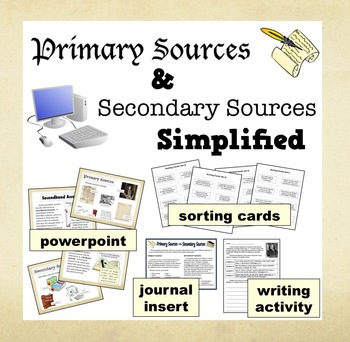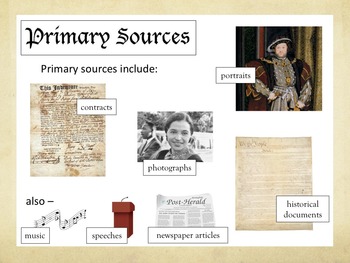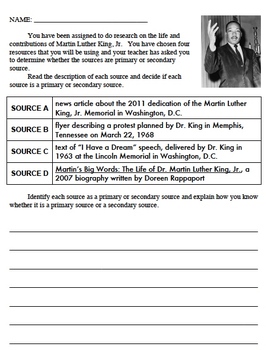Primary & Secondary Sources Simplified – PPT + Printables bundle
Rogue Algorithm
1.8k Followers
What educators are saying
This was perfect to teach my 6th graders the difference between primary and secondary sources. Lesson was quick, engaging, and easy to understand.
This was a great resource to have on hand to enhance my lessons with the students. Thanks so much! :)
Description
The Common Core ELA State Standards demand that students be exposed to a wide variety of challenging literary and informational texts. Increasingly, our children will need to be able to read and analyze a mix of primary and secondary sources as they build their content knowledge. This set of activities is designed to introduce your students to the concept of primary and secondary sources, as well as the difference between firsthand and secondhand accounts (RI.4.6). It includes:
• 10-slide powerpoint presentation illustrating the differences between primary sources/firsthand accounts and secondary sources/secondhand accounts
• journal-sized reference graphic with definitions and examples of each type of source
• four sets of eight primary/secondary source sorting cards, sorting mat, and answer keys
• thirty-two primary/secondary source Scoot cards (containing the same descriptions as the sorting cards), Scoot recording sheet, and answer key
• primary/secondary source writing activity and key
Begin by using the Primary Sources and Secondary Sources Powerpoint presentation (a .pptx file) to introduce (or review, if you have already taught this concepts) the difference between primary and secondary historical sources. Distribute a copy of the Primary Sources vs. Secondary Sources graphic to each student for them to use as a reference as they work on the sorts.
Once the students know the difference between the two types of sources, use the sorting cards to help them review what they have learned. There are four sets of cards, with eight cards in each set. Each set focuses on a specific person or time period in history – George Washington, the Pilgrims, the Jamestown settlement, and Abraham Lincoln – and contains descriptions of four primary sources and four secondary sources. (While these cards may relate to topics that your students have not studied, none of the cards require anything other than a general familiarity on the part of your students.)
Copy and cut the cards out along the lines, and place each set in its own envelope. Give each student, pair, or group a set of cards and a sorting mat and have them work together to sort the cards. Then, give out the answer keys so they can check the placement of their cards. The kids then put their cards back together, mix them up so they are in random order, and put them back in their original envelope. You then rotate the envelopes so each group has a new set of cards to sort (A passing to B, B to C, etc.). Once done, your kids will have examined all four sets of primary/secondary source cards!
As an alternative to the sort, you can have your students explore with the same primary and secondary sources by playing Scoot. Included in this set are numbered cards designed for playing Scoot. The cards have the same descriptions as the sorting cards, but are numbered to correlate with the Scoot recording sheet. To play Scoot, give each child a recording sheet, and place a numbered Scoot card on each desk. [There are 32 cards to accommodate classes up to 32, but you can use less depending on the number of students in your class.] Each student reads his or her card, decide if the described source is primary or secondary, and then writes the word primary or secondary in the box whose number matches the number on the card. Then, students “scoot” over to the next numbered card, repeating the process of reading, recording, and scooting until they have examined all the cards. Once done, display the answer key to review the cards and have students check their work.
Wrap it all up by checking your students’ understanding with the Martin Luther King, Jr. writing activity. Students will read four descriptions of sources that could be used to research the life and contributions of Dr. Martin Luther King, Jr., identify whether each description tells about if a primary or secondary source, and explain how they know.
I designed these activities for my own fourth grade class as I found many primary/secondary source activities to be geared towards middle and high schoolers and, as such, somewhat inaccessible for the range of readers in my elementary classroom. I wanted to be able to give my kids an understanding of an important informational literacy concept in a way that would be relatable and engaging. I hope that these resources are as useful to you and your students as they were for mine!
• 10-slide powerpoint presentation illustrating the differences between primary sources/firsthand accounts and secondary sources/secondhand accounts
• journal-sized reference graphic with definitions and examples of each type of source
• four sets of eight primary/secondary source sorting cards, sorting mat, and answer keys
• thirty-two primary/secondary source Scoot cards (containing the same descriptions as the sorting cards), Scoot recording sheet, and answer key
• primary/secondary source writing activity and key
Begin by using the Primary Sources and Secondary Sources Powerpoint presentation (a .pptx file) to introduce (or review, if you have already taught this concepts) the difference between primary and secondary historical sources. Distribute a copy of the Primary Sources vs. Secondary Sources graphic to each student for them to use as a reference as they work on the sorts.
Once the students know the difference between the two types of sources, use the sorting cards to help them review what they have learned. There are four sets of cards, with eight cards in each set. Each set focuses on a specific person or time period in history – George Washington, the Pilgrims, the Jamestown settlement, and Abraham Lincoln – and contains descriptions of four primary sources and four secondary sources. (While these cards may relate to topics that your students have not studied, none of the cards require anything other than a general familiarity on the part of your students.)
Copy and cut the cards out along the lines, and place each set in its own envelope. Give each student, pair, or group a set of cards and a sorting mat and have them work together to sort the cards. Then, give out the answer keys so they can check the placement of their cards. The kids then put their cards back together, mix them up so they are in random order, and put them back in their original envelope. You then rotate the envelopes so each group has a new set of cards to sort (A passing to B, B to C, etc.). Once done, your kids will have examined all four sets of primary/secondary source cards!
As an alternative to the sort, you can have your students explore with the same primary and secondary sources by playing Scoot. Included in this set are numbered cards designed for playing Scoot. The cards have the same descriptions as the sorting cards, but are numbered to correlate with the Scoot recording sheet. To play Scoot, give each child a recording sheet, and place a numbered Scoot card on each desk. [There are 32 cards to accommodate classes up to 32, but you can use less depending on the number of students in your class.] Each student reads his or her card, decide if the described source is primary or secondary, and then writes the word primary or secondary in the box whose number matches the number on the card. Then, students “scoot” over to the next numbered card, repeating the process of reading, recording, and scooting until they have examined all the cards. Once done, display the answer key to review the cards and have students check their work.
Wrap it all up by checking your students’ understanding with the Martin Luther King, Jr. writing activity. Students will read four descriptions of sources that could be used to research the life and contributions of Dr. Martin Luther King, Jr., identify whether each description tells about if a primary or secondary source, and explain how they know.
I designed these activities for my own fourth grade class as I found many primary/secondary source activities to be geared towards middle and high schoolers and, as such, somewhat inaccessible for the range of readers in my elementary classroom. I wanted to be able to give my kids an understanding of an important informational literacy concept in a way that would be relatable and engaging. I hope that these resources are as useful to you and your students as they were for mine!
Total Pages
30 pages
Answer Key
Included
Teaching Duration
N/A
Report this resource to TPT
Reported resources will be reviewed by our team. Report this resource to let us know if this resource violates TPT’s content guidelines.





